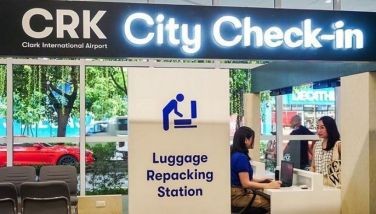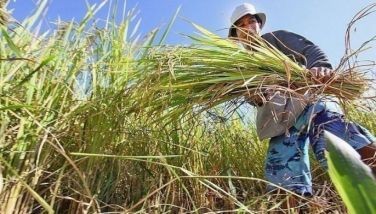Filipino fisherfolk among the 'poorest of the poor'
MANILA, Philippines - Some 300,000 Filipino fishery workers “toil like slaves” in aquaculture farms and on commercial fishing vessels for pay below minimum wage.
This was revealed during a recent four-day consultation-workshop with the United Nations Food and Agricultural Organization (UN-FAO) in Angeles, Pampanga.
The gathering also brought to the attention of the UN-FAO fears on the displacement of some 3.9 million fishermen and residents in the implementation of the Laguna Lake Master Plan, among other concerns.
Also noted in the four-day gathering were studies indicating that majority of the the country’s “poorest of the poor” are now found in coastal areas.
Thus, some 50 representatives of fisherfolk associations and other non-government organizations appealed to officials of the UN-FAO “to discover for themselves why small-scale fishermen in the country belong to the poorest of the poor despite the country’s rich marine resources.”
The open invitation was extended by leaders of the Pambansang Lakas ng Kilusang Mamamalakaya ng Pilipinas (Pamalakaya) during the Philippine Consultation and Workshops on UN-FAO Vision Guidelines on Small-Scale Fisheries held in Quezon City from Jan. 27-30, 2012.
The consultation-workshop was endorsed by the World Forum of Fisher People (WFFP), of which Pamalakaya is a member.
The UN-FAO is developing international guidelines that would further promote the rights of small-scale fishermen under the human rights approach, said Pamalakaya national chairman Fernando Hicap.
Hicap urged the UN-FAO to send to the country its special rapporteur on the right to food, Oliver de Schutter, “to conduct a thorough investigation on the poverty of small fisherfolk and the destruction of fish sources across the country.”
According to Hicap, “Development projects such as eco-tourism and ecozone projects funded by foreign capital promote destruction of fishery resources and further violate the rights of small fisherfolk all over the country.”
Hicap said the four-day consultation-workshop came to the conclusion that “the poorest of the poor in the Philippines are found in coastal communities.” No specifics on this was immediately disclosed.
“The participants said small-scale fisheries production in the country is characterized by backward, scattered and small-scale production which is reflective of the very low level of technology in capture fisheries,” he added
Hicap said the participants noted that such backwardness “is further compounded or complicated by the high cost of production in fish capture, thus making life more miserable to poor fishing families.”
Hicap added, “They also complained about the zero-institutional support of the national and local governments and their agencies to small fisherfolk and they noted that only the commercial fishing and aquaculture sector receive financial subsidies from the government in the form of oil subsidies, tax holidays and capital support due to their engagement in the exportation of fishery items to foreign countries.”
The participants also complained to the UN-FAO about “the monopoly control of big fishing interest of fishing boats and other fishing technologies and capital in fisheries which allow them to harvest more at the expense of small fisherfolk and to the detriment of the marine environment.”
The UN-FAO has been holding consultation-workshops in 24 countries, including marine-rich fishing nations like Pakistan, Thailand, India and Costa Rica where the livelihood and economic rights of small-scale fisheries are reported to be threatened by current global developments such as the privatization and conversion of communal fishing areas.
Hicap said Filipino participants in the recent gathering cited several projects highly inimical to small-scale fisheries.
The projects cited include the Laguna Lake Master Plan which involve 54 major projects and would displace about 3.9 million fishermen and residents along the lake; the Manila Bay Master Development Plan that involve the privatization and conversion of the bay; the offshore mining for oil and gas in West Philippine Sea; the widespread black sand mining in Lingayen Gulf, Zambales and Aurora in Central Luzon, Cagayan, Albay, Eastern Visayas, Negros and Panay Island, and the mushrooming of eco-tourism driven fish sanctuaries in Central Visayas and other parts of Luzon and Mindanao.
Hicap also cited the case of the Aurora Pacific Economic and Free Port Zone project in Aurora Province and the Pampanga Delta Development Project in Pampanga and some parts of Bulacan province which, he noted, “deserve the attention of the UN-FAO, as these projects also adversely affect fish sources and fisherfolk livelihood.”
Pamalakaya leaders and their NGO partners also raised the need to provide production and oil subsidies to small fisherfolk in the country.
According to Hicap, a comprehensive program that would improve the level of technology and production is needed to make sure the fish need of over 100 million Filipinos is supplied by local production.
Pamalakaya has been batting for a yearly P32-billion oil subsidy for small fisherfolk with small fishing boats and paddle-driven bancas to mitigate the impact of unbridled increases in the prices of petroleum products.
Pamalakaya has also urged the government to immediately provide relief and pursue rehabilitation of small fishing communities ravaged by yearly disasters and calamities, and assistance should be in the form of grant and not loan to affected fishers.
“We have also urged UN-FAO to investigate the sorry plight of fish workers in the commercial and aquaculture sectors who are overworked and underpaid, receiving wages below the minimum wage prescribed by law,” Hicap said.
Pamalakaya said about 300,000 fish workers in the country work like slaves inside aquaculture farms and aboard commercial fishing vessels receiving an average of P 200 per day, way below the P427 minimum wage (in Metro Manila), Hicap said.
The participants during the four-day UN- FAO affair came from Aurora and Bulacan in Central Luzon, La Union, Ilocos Sur and Ilocos Norte in Region 1, Cavite, Laguna, Batangas, Rizal, Quezon and Palawan provinces in Southern Tagalog Region, Albay, Sorsogon and Masbate in Bicol Region, Cebu in Central Visayas, Iloilo and Capiz in Panay Island and Northern Mindanao region.
- Latest
























